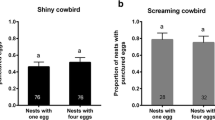Abstract
Studies of avian brood parasitism have provided some of the best evidence of coevolutionary arms races. One of the parasitic adaptations exhibited by cuckoos (family Cuculidae) and cowbirds (family Icteridae) is the development of a thick eggshell, presumably to avoid damage from puncture ejection by some hosts and/or accidental damage during egg-laying in the host nest. However, it is unknown whether this trait constrains the hatching of parasitic young. The differences in hatching characteristics between the host red-winged blackbird (“redwing;” Agelaius phoeniceus) and the parasitic brown-headed cowbird (Molothrus ater) were examined. Prehatched cowbird young were found to spend more time hatching than pre-hatched redwing young and to emit click sounds at a greater rate in relation to pulmonary respiration than pre-hatched redwing young. However, cowbird hatchlings appear to have evolved other hatching-related traits that may compensate for the greater hatching effort, such as body parts and an egg tooth that are relatively large compared with those of redwing hatchlings.



Similar content being viewed by others
References
Blankespoor GW, Oolman J, Uthe C (1982) Eggshell strength and cowbird parasitism of red-winged blackbirds. Auk 99:363–365
Brooker MG, Brooker LC (1991) Eggshell strength in cuckoos and cowbirds. Ibis 133:406–413
Curson DR, Mathews NE (2003) Reproductive costs of commuting flights in brown-headed cowbirds. J Wildl Manag 67:520–529
Davies NB (2000) Cuckoos, cowbirds and other cheats. T & AD Poyser Ltd, London
Davies JC, Cooke F (1983) Intraclutch hatch synchronization in the lesser snow goose. Can J Zool 61:1398–1401
Davies NB, Kilner RM, Noble DG (1998) Nestling cuckoos, Cuculus canorus, exploit hosts with begging calls that mimic a brood. Proc R Soc Lond B 265:673–678
Dearborn DC (1998) Begging behavior and food acquisition by brown-headed cowbird nestlings. Behav Ecol Sociobiol 43:259–270
Dearborn DC (1999) Brown-headed cowbird nestling vocalizations and risk of nest predation. Auk 116:448–457
Driver PM (1965) “Clicking” in the egg-young of nidifugous birds. Nature 205:315
Driver PM (1967) Notes on the clicking of avian egg-young, with comments on its mechanism and function. Ibis 109:434–437
Glassey B, Forbes S (2003) Why brown-headed cowbirds do not influence red-winged blackbird parent behavior. Anim Behav 65:1235–1246
Grim T (2005) Mimicry vs. similarity: which resemblances between brood parasites and their hosts are mimetic and which are not? Biol J Linn Soc 84:69–78
Honza M, Picman J, Grim T, Novák V, Ćapek M, Mrlík V (2001) How to hatch from an egg of great structural strength: a study of the Common Cuckoo. J Avian Biol 32:249–255
Hoover JP, Reetz MJ (2006) Brood parasitism increases provisioning rate, and reduces offspring recruitment and adult return rates, in a cowbird host. Oecologia 149:165–173
Kilner RM (2003) How selfish is a cowbird nestling? Anim Behav 66:569–576
Kilner RM, Madden JR, Hauber ME (2004) Brood parasitic cowbird nestlings use host young to procure resources. Science 305:877–879
Kilpatrick AM (2002) Variation in growth of brown-headed cowbird (Molothrus ater) nestlings and energetic impacts on their host parents. Can J Zool 80:145–153
Krüger O (2007) Cuckoos, cowbirds and hosts: adaptations, trade-offs and constraints. Philos Trans R Soc B 362:1873–1886
Lichtenstein G, Sealy SG (1998) Nestling competition, rather than supernormal stimulus, explains the success of parasitic brown-headed cowbird chicks in yellow 314 warbler nests. Proc R Soc Lond B 265:249–254
Lowther PE (1993) Brown-headed Cowbird, Molothrus ater. In: Poole A, Gill F (eds) The birds of North America, no. 47. Academy of Natural Sciences/American Ornithologists’ Union, Philadelphia/Washington, DC
McCoshen JA, Thompson RP (1968) A study of clicking and its source in some avian species. Can J Zool 46:169–172
McMaster DG, Sealy SG (1998) Short incubation periods of brown-headed cowbirds: how do cowbird eggs hatch before yellow warbler eggs? Condor 100:102–111
Mermoz ME, Ornelas JF (2004) Phylogenetic analysis of life-history adaptations in parasitic cowbirds. Behav Ecol 15:109–119
Oppenheim RW (1972) Prehatching and hatching behavior in birds: a comparative study of altricial and precocial species. Anim Behav 20:644–655
Orcutt FS, Orcutt AB (1976) Nesting and parental behavior in domestic common quail. Auk 93:135–141
Ortega CP (1998) Cowbirds and other brood parasites. University of Arizona, Tucson
Ortega CP, Cruz A (1992) Differential growth patterns of nestling brown-headed cowbirds and yellow-headed blackbirds. Auk 109:368–376
Payne RB (2005) The cuckoos. Oxford University Press, Oxford
Picman J (1989) Mechanism of increased puncture resistance of eggs of brown-headed cowbirds. Auk 106:577–583
Picman J (1997) Are cowbird eggs unusually strong from the inside? Auk 114:66–73
Rothstein SI, Robinson SK (1998) Parasitic birds and their hosts: studies in coevolution. Oxford University Press, New York
SAS (2011) SAS/STAT 9.3 user’s guide: mixed modelling (book excerpt). SAS Institute Inc., Cary
Soler JJ, Aviles JM, Soler M, Møller AP (2003) Evolution of host egg mimicry in a brood parasite, the great spotted cuckoo. Biol J Linn Soc 79:551–563
Spaw CD, Rohwer S (1987) A comparative study of eggshell thickness in cowbirds and other passerines. Condor 89:307–318
Strausberger BM (1998) Temperature, egg mass, and incubation time: a comparison of brown-headed cowbirds and red-winged blackbirds. Auk 115:843–850
Vince MA (1966) Artificial acceleration of hatching in quail embryos. Anim Behav 14:389–394
Vince MA (1969) Embryonic communication, respiration and the synchronization of hatching. In: Hinde RA (ed) Bird vocalization. Cambridge University Press, Cambridge, pp 233–260
Yasukawa K, Searcy WA (1995) Red-winged Blackbird (Agelaius phoeniceus). In: Poole A (ed) The birds of North America. Cornell Lab of Ornithology, Ithaca
Acknowledgments
This study was approved by the University Committee on the Use and Care of Animals, University of Michigan, Ann Arbor. I gratefully acknowledge many helpful comments from R.B. Payne and additional suggestions from several anonymous reviewers.
Author information
Authors and Affiliations
Corresponding author
About this article
Cite this article
Yoon, J. Comparative hatching characteristics of nonparasitic and parasitic icterids: is the hatching of cowbird young constrained by an unusually thick eggshell?. J Ethol 31, 35–40 (2013). https://doi.org/10.1007/s10164-012-0346-9
Received:
Accepted:
Published:
Issue Date:
DOI: https://doi.org/10.1007/s10164-012-0346-9




